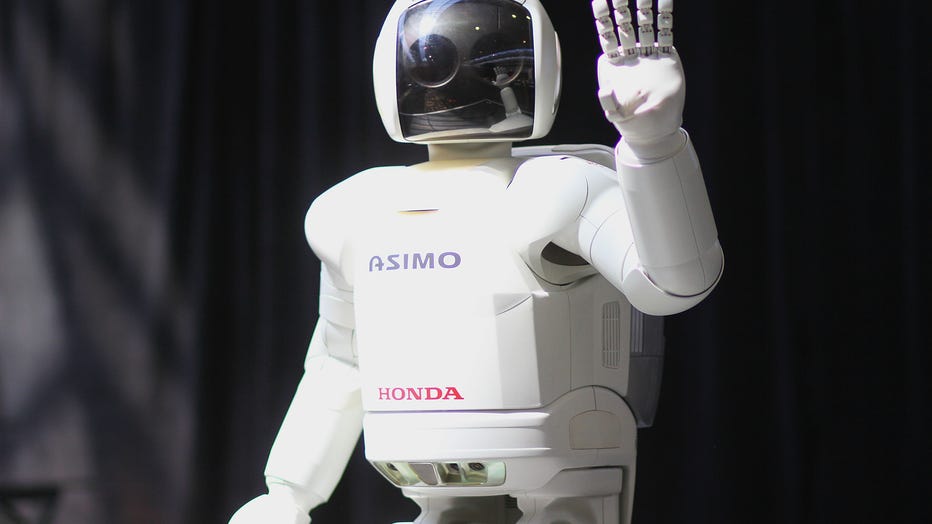Tesla's Elon Musk unveils humanoid robot Optimus prototype with expected $20K price tag
Tesla CEO Elon Musk smiles as he addresses guests at the Offshore Northern Seas 2022 (ONS) meeting in Stavanger, Norway on August 29, 2022. (Photo by CARINA JOHANSEN/NTB/AFP via Getty Images)
An early prototype of Tesla Inc.'s proposed Optimus humanoid robot slowly and awkwardly walked onto a stage, turned, and waved to a cheering crowd at the company's artificial intelligence event Friday.
But the basic tasks by the robot with exposed wires and electronics — as well as a later, next generation version that had to be carried onstage by three men — was a long way from CEO Elon Musk's vision of a human-like robot that can change the world.
Musk told the crowd, many of whom might be hired by Tesla, that the robot can do much more than the audience saw Friday. He said it is also delicate and "we just didn’t want it to fall on its face."
RELATED: Elon Musk's floating Cybertruck tweet torpedoed by government agencies
Musk suggested that the problem with flashy robot demonstrations is that the robots are "missing a brain" and don’t have the intelligence to navigate themselves, but he gave little evidence Friday that Optimus was any more intelligent than robots developed by other companies and researchers.
The demo didn’t impress AI researcher Filip Piekniewski, who tweeted it was "next level cringeworthy" and a "complete and utter scam." He said it would be "good to test falling, as this thing will be falling a lot."
"None of this is cutting edge," tweeted robotics expert Cynthia Yeung. "Hire some PhDs and go to some robotics conferences @Tesla."
Yeung also questioned why Tesla opted for its robot to have a human-like hand with five fingers, noting "there’s a reason why" warehouse robots developed by startup firms use pinchers with two or three fingers or vacuum-based grippers.
Musk said that Friday night was the first time the early robot walked onstage without a tether. Tesla's goal, he said, is to make an "extremely capable" robot in high volumes — possibly millions of them — at a cost that could be less than a car, that he guessed would be less than $20,000.
Tesla showed a video of the robot, which uses artificial intelligence that Tesla is testing in its "Full Self-Driving" vehicles, carrying boxes and placing a metal bar into what appeared to be a factory machine. But there was no live demonstration of the robot completing the tasks.
Employees told the crowd in Palo Alto, California, as well as those watching via livestream, that they have been working on Optimus for six to eight months. People can probably buy an Optimus "within three to five years," Musk said.
READ MORE: Tesla owner says he’s locked out after battery died, replacement costs $26K
Employees said Optimus robots would have four fingers and a thumb with a tendon-like system so they could have the dexterity of humans.
The robot is backed by giant artificial intelligence computers that track millions of video frames from "Full Self-Driving" autos. Similar computers would be used to teach tasks to the robots, they said.
Experts in the robotics field were skeptical that Tesla is anywhere near close to rolling out legions of human-like home robots that can do the "useful things" Musk wants them to do — say, make dinner, mow the lawn, keep watch on an aging grandmother.
RELATED: Tunnel to tomorrow? Elon Musk's Las Vegas Loop is now open for business
"When you’re trying to develop a robot that is both affordable and useful, a humanoid kind of shape and size is not necessarily the best way," said Tom Ryden, executive director of the nonprofit startup incubator Mass Robotics.
Tesla isn’t the first car company to experiment with humanoid robots.

Honda's humanoid robot ASIMO appears during the FIRST Championships at the America's Center on April 28, 2011 in St. Louis, Missouri. (Photo by Dilip Vishwanat/Getty Images for Honda)
Honda more than two decades ago unveiled Asimo, which resembled a life-size space suit and was shown in a carefully-orchestrated demonstration to be able to pour liquid into a cup. Hyundai also owns a collection of humanoid and animal-like robots through its 2021 acquisition of robotics firm Boston Dynamics. Ford has partnered with Oregon startup Agility Robotics, which makes robots with two legs and two arms that can walk and lift packages.
Ryden said carmakers’ research into humanoid robotics can potentially lead to machines that can walk, climb and get over obstacles, but impressive demos of the past haven't led to an "actual use scenario" that lives up to the hype.
"There’s a lot of learning that they’re getting from understanding the way humanoids function," he said. "But in terms of directly having a humanoid as a product, I’m not sure that that’s going to be coming out anytime soon."
READ MORE: Metro Detroit man implants Tesla key into hand to unlock, start car
Critics also said years ago that Musk and Tesla wouldn't be able to build a profitable new car company that used batteries for power rather than gasoline.
Tesla is testing "Full Self-Driving" vehicles on public roads, but they have to be monitored by selected owners who must be ready to intervene at all times. The company says it has about 160,000 vehicles equipped with the test software on the road today.
Critics have said the Teslas, which rely on cameras and powerful computers to drive by themselves, don't have enough sensors to drive safely. Tesla's less capable Autopilot driver-assist system, with the same camera sensors, is under investigation by U.S. safety regulators for braking for no reason and repeatedly running into emergency vehicles with flashing lights parked along freeways.
In 2019, Musk promised a fleet of autonomous robotaxis would be in use by the end of 2020. They are still being tested.

